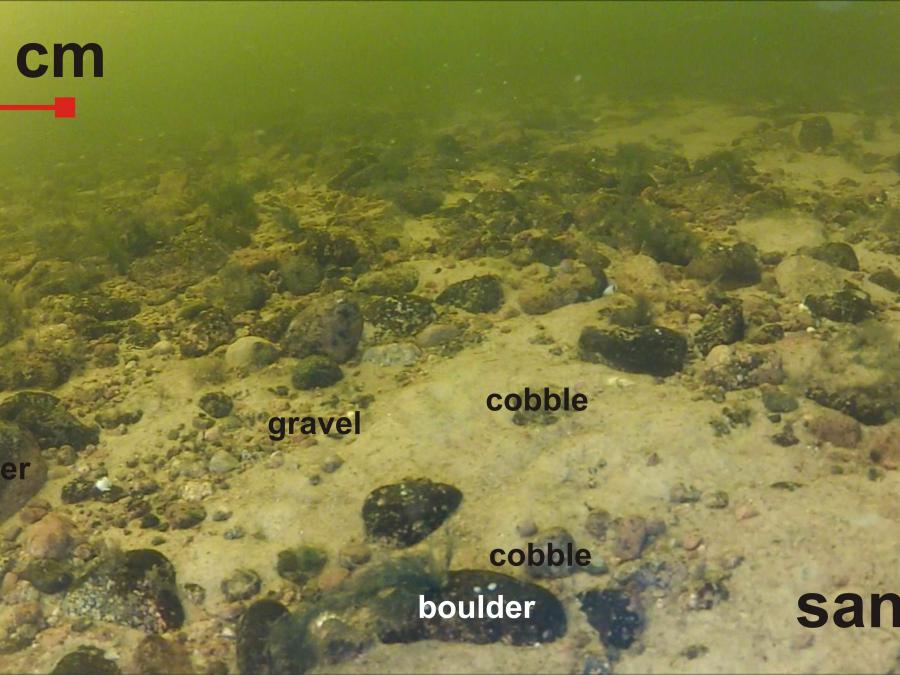Glossary (eng)
Some of the interface text in Estonian and Finnish is machine-translated
| The term in English | The term in Russian | The term in the Estonian | The term in Finnish | Term article | Photo |
|---|---|---|---|---|---|
| Sand | Песок | Liiv | Hiekka, Santa | Sediment grains between 0.06 and 2 mm (FIN) and 0.05 and 2 mm (RUS) in size. |

|
| Sand waves | Песчаные волны | Liivaluited | Hiekka-aalto (laaja hiekkainen virtausmuoto), Dyyni | Are a type of flow-transverse sedimentary bedforms. Sand waves are generally more than 1 m (sometimes even 6 m) m in height, more than 10 m in wavelength (crest–crest spacing), and typically they have smaller dunes superimposed. They are found in most tidal bays and estuaries and on the seabed wherever currents exceed a speed of around 1 m/s. Sand waves are generally asymmetric in profile and move downstream as the upstream slope is eroded and sediment is deposited on the downstream or lee slope. Their lee slopes are generally around 100, much less steep than the angle of repose of sand. Sand waves are so large that they do not normally reverse their asymmetry over a 12 h tidal cycle. Their crestlines may be either linear (two dimensional) or nonlinear (three dimensional or barchan-shaped) in plan view. Typical flow velocity for ripples generating is about 40-80 cm/sec. |
|
| Sandbank | Песчаная банка, отмель | Liivavallid | Hiekkapenkka | (or tidal current ridge) (1) In geology type of sedimentary barform. Sandbanks are elongate sediment deposits common in macrotidal environments, ranging from 100s of meters to many kilometers in length, 10s to 100s of meters in width, and rising from the seabed to the intertidal zone. Sandbank crests are commonly exposed at low tide. They are aligned with their long axis subparallel to the main current. (2) Sandbanks are elevated, elongated, rounded or irregular topographic features, permanently submerged and predominantly surrounded by deeper water. They consist mainly of sandy sediments, but larger grain sizes, including boulders and cobbles, or smaller grain sizes including mud may also be present on a sandbank. Banks where sandy sediments occur in a layer over hard substrata are classed as sandbanks if the associated biota are dependent on the sand rather than on the underlying hard substrata. "Slightly covered by sea water all the time" means that above a sandbank the water depth is seldom more than 20 m below chart datum. Sandbanks can, however, extend beneath 20 m below chart datum. It can, therefore, be appropriate to include in designations such areas where they are part of the feature and host its biological assemblages. (EU’s Habitats Directive underwater habitats, http://ec.europa.eu/environment/nature/legislation/habitatsdirective/docs/Int_Manual_EU28.pdf) |
|
| Scenario | Сценарий (в моделировании) | Stsenaarium | Skenaario | A plausible and often simplified description of how the future may develop, based on a coherent and internally consistent set of assumptions about key driving forces (e.g., rate of technology change, prices) and relationships. Scenarios are neither predictions nor projections and sometimes may be based on a ‘‘narrative storyline.’’ Scenarios may include projections but are often based on additional information from other sources. |
|
| Seagrass | Водные цветковые растения | Merihein | Vedenalainen niitty | Flowering plants from one of four plant families (Posidoniaceae, Zosteraceae,Hydrocharitaceae, and Cymodoceaceae), all in the order Alismatales (in the class of monocotyledons), which grow from brackish to fully saline environments. See also Phanerogam meadows, Eelgrass. |
|
| Seasonal migration | Сезонная миграция | Hooajaline ränne | Vuodenaikaisvaellus, vuodenaikaismigraatio | Periodic movement of a population from one region or climate to another in accordance with the yearly cycle of weather and temperature changes. |
|
| Secondary coast | Берега, измененные морем | Sekundaarne rannik | Sekundääriranta | Stage of evolution of primary equable shore. Develops as a result of selective abrasion. |
|
| Secondary pollution | Вторичное загрязнение вод | Sekundaarne saastumine | Sekundäärinen saastuminen | (Russian Federation GOST 27065-86) A Pollution as a result of transformation of those substances that were brough into the system before via mass development of certain organisms and decaying their dead biomass. |
|
| Secondary sand | Покровные пески | Sekundaarne liiv | Sekundaarinen hiekka, sekundaarihiekka | Sand composed of particles derived from the erosion or weathering of preexisting substrate. |
|
| Sedimentary rock | Осадочные породы | Settekivim | Sedimenttikivi | Rock formed by the accumulation of sediment in water (aqueous deposits) or from air (eolian deposits). The sediment may consist of rock fragments or particles of various sizes (conglomerate sandstone, shale); of the remains or products of animals or plants (certain limestones and coal); of the product of chemical action or of evaporation (salt, gypsum, etc.); or of mixtures of these materials. Some sedimentary deposits (tuffs) are composed of fragments blown from volcanoes and deposited on land or in water. A characteristic feature of sedimentary deposits is a layered structure known as bedding or stratification. Each layer is a bed or stratum. Sedimentary beds as deposited lie flat or nearly flat. In the Eastern Gulf of Finland they include mainly marine clayey-silty Vendian deposits. |
